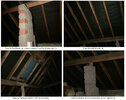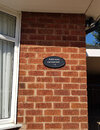- Joined
- 5 Nov 2024
- Messages
- 5
- Reaction score
- 0
- Country

Hi.
I am buying a house which is a 1957 bungalow. It's a Hips roof and so there are 4 purlins. The longer purlins of the 4 are both supported by 2 corbels which are made up of about ~10 courses of bricks and seem to be about maybe 400-500mm wide. The weird thing is that the actual purlin is only supported by one brick. That brick has had a notch cut in it for the purlin to sit in.
I want to find out if anyone has seen it done this way before and is it OK? I thought it looked quite sketchy, and so did my surveyor, but I made the mistake of telling him my opinions of the house before he inspected it. I'm worried he is covering himself by agreeing with me in case there is a problem. I have searched the internet and can't find a picture of a purlin supported by a single brick like this. I am new to thinking about buildings though so maybe I didn't search in the right places. All 4 of the corbels are like this and then just have the single brick support.
Thanks for reading this. Any advice would be greatly appreciated.
I am buying a house which is a 1957 bungalow. It's a Hips roof and so there are 4 purlins. The longer purlins of the 4 are both supported by 2 corbels which are made up of about ~10 courses of bricks and seem to be about maybe 400-500mm wide. The weird thing is that the actual purlin is only supported by one brick. That brick has had a notch cut in it for the purlin to sit in.
I want to find out if anyone has seen it done this way before and is it OK? I thought it looked quite sketchy, and so did my surveyor, but I made the mistake of telling him my opinions of the house before he inspected it. I'm worried he is covering himself by agreeing with me in case there is a problem. I have searched the internet and can't find a picture of a purlin supported by a single brick like this. I am new to thinking about buildings though so maybe I didn't search in the right places. All 4 of the corbels are like this and then just have the single brick support.
Thanks for reading this. Any advice would be greatly appreciated.


